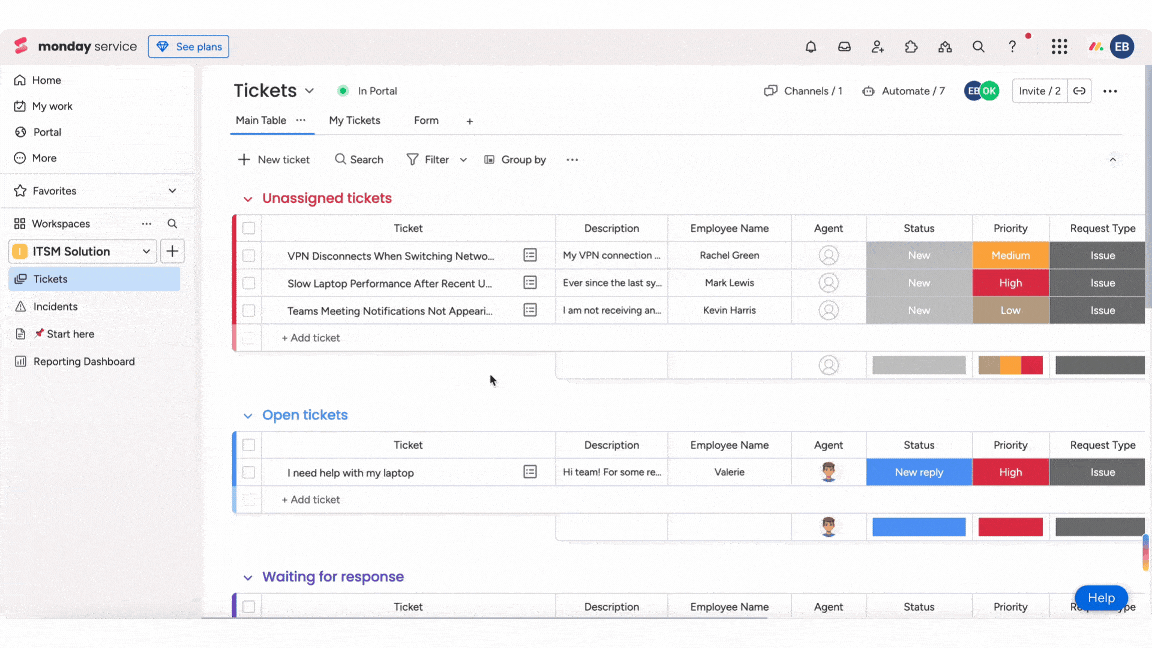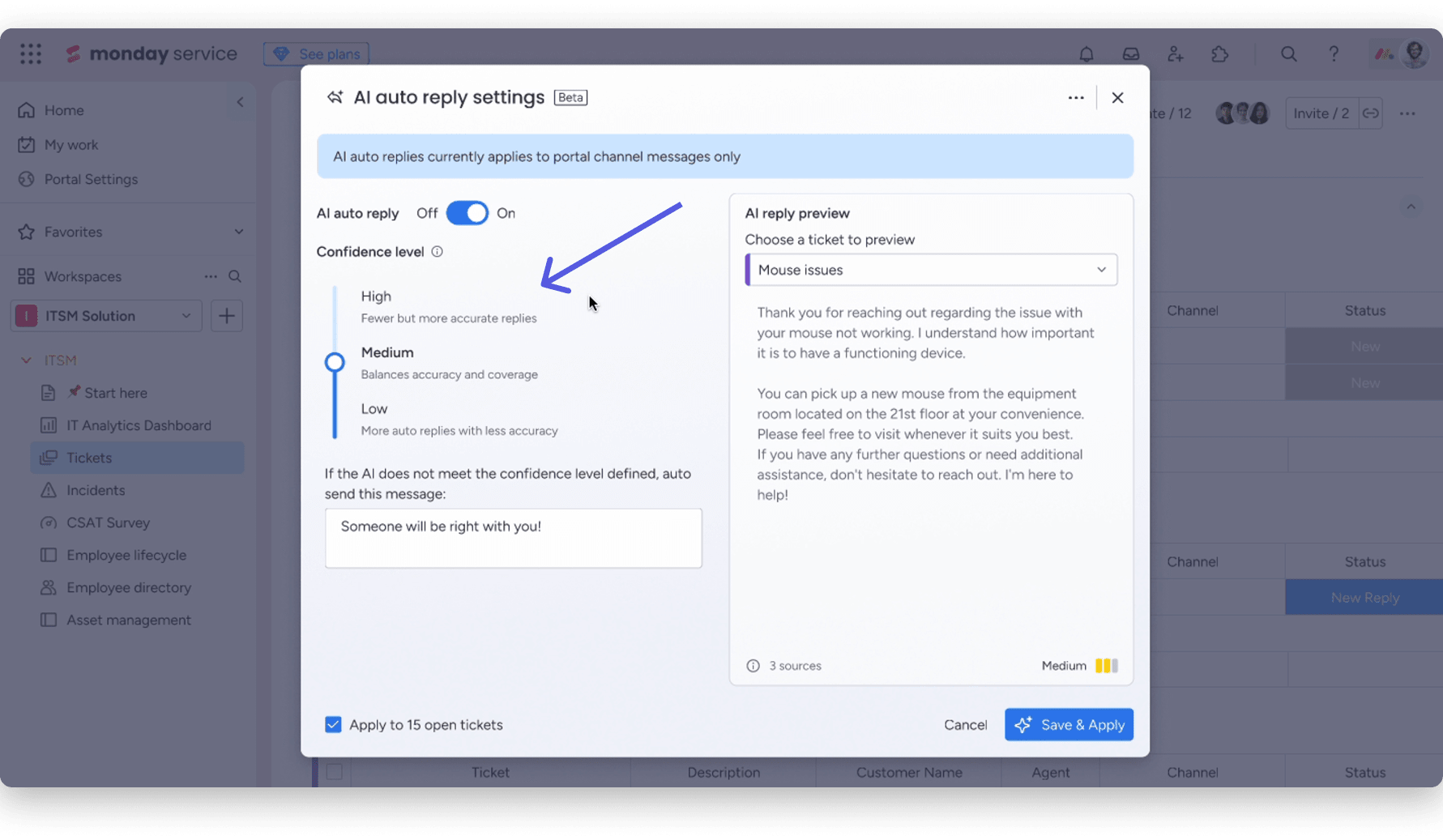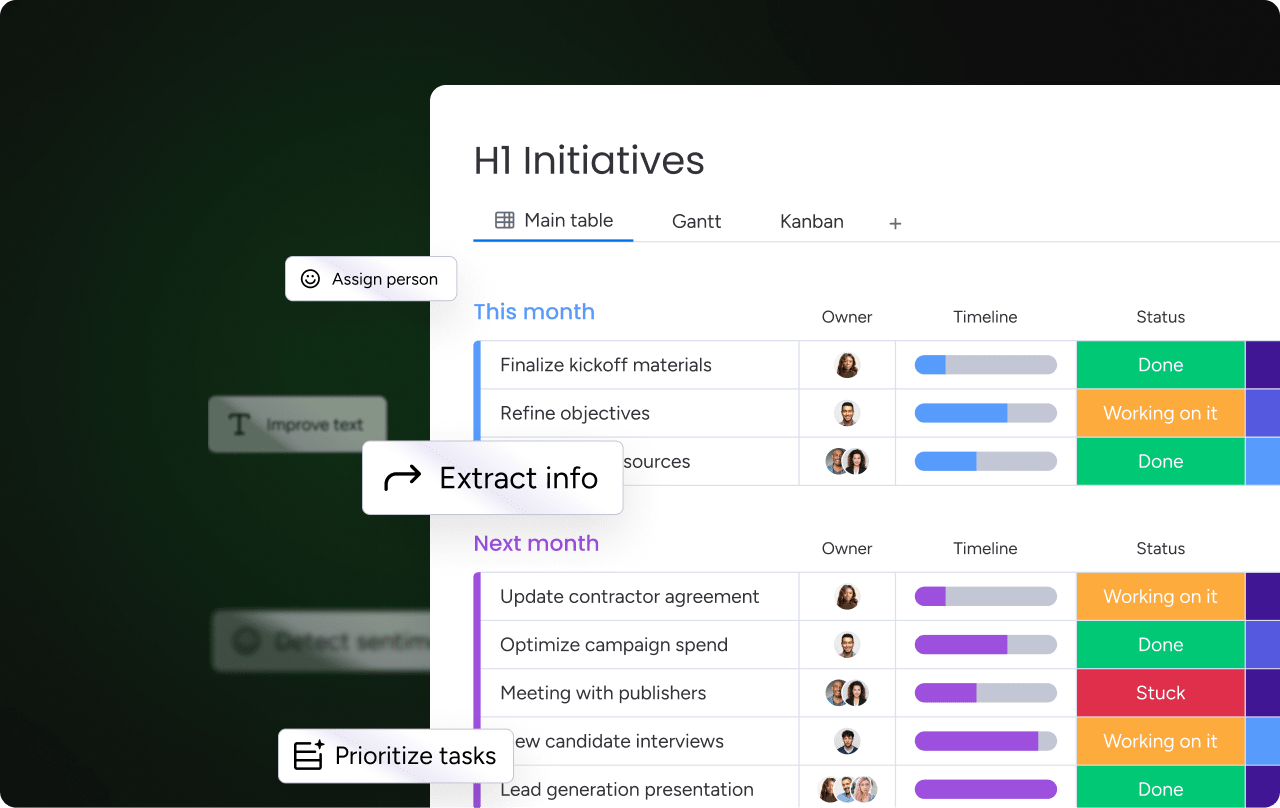Support teams are handling more requests than ever, while customer expectations continue to rise. People expect instant replies, human-like service, and around-the-clock availability, without compromising quality.
Meeting these demands is tough when teams rely on disconnected systems and manual processes. Delayed responses, inconsistent interactions, and rising burnout are often the result.
AI offers a smarter way forward. By taking over repetitive work and surfacing relevant context, AI allows teams to respond with clarity and accuracy, not just speed. From routing tickets to suggesting responses, AI brings structure, focus, and momentum to the entire support workflow.
This guide breaks down how AI fits into modern service operations, how it drives impact, and how platforms like monday service help teams scale with confidence.
What is AI in customer service, and how does it work?
AI in customer service refers to the use of machine learning, natural language processing, and generative tools to improve service workflows. These technologies reduce manual effort, improve response quality, and allow teams to manage higher volumes without added complexity.
AI typically works behind the scenes — analyzing historical tickets, identifying patterns, and recommending next steps based on context. It’s already an essential part of many support operations, helping teams move quicker and deliver more consistent experiences.
Rather than replacing agents, AI complements their work. It manages repeatable tasks, flags key insights, and ensures agents are focused on the issues that require their expertise.
It’s already embedded in many service teams’ daily operations, powering everything from ticket triage to quality management. Internally, teams are also applying AI to IT, HR, and legal support to deliver faster, more aligned service across the organization.
Some of the most common ways teams put AI to work:
- Ticket classification and routing: AI tags and assigns tickets based on urgency, sentiment, or topic to ensure the right person handles the right issue.
- Reply suggestions: Draft responses are generated based on similar past cases, giving agents a quicker starting point.
- Thread summarization: Key details from long email threads or conversations are extracted, helping agents take action quickly.
- Sentiment detection: Emotionally charged messages are flagged so agents can prioritize them and respond appropriately.
- Insight generation: AI highlights patterns in CSAT scores, ticket volume, or recurring issues, helping teams plan ahead.
When used thoughtfully, AI becomes a scalable support layer that improves agent productivity, enhances service quality, and supports growing ticket volumes, both for customer-facing and internal teams.
How to get started with AI in customer service
Rolling out AI doesn’t have to mean overhauling your tech stack. Teams see the most success when they begin with a clear, contained use case and expand as value becomes visible.
Identify a high-impact use case
Start with a process that’s repetitive, high-volume, and easy to measure. These use cases are easier to automate and validate, and they offer a fast path to ROI.
Look for workflows with these traits:
- High volume: The task repeats often (e.g., ticket triage)
- Low complexity: It doesn’t require nuanced decision-making
- Clear metrics: You can easily compare before and after
- Low risk: There’s minimal downside if it doesn’t perform
- Agent friction: It’s time-consuming or tedious
Think ticket classification, routing, or initial response generation, which are all great starting points.
Set up with transparency and controls
AI adoption works best when it earns agent trust. That means showing how it works and keeping humans in control.
Build confidence and accountability by:
- Assigning clear ownership for setup and testing — typically a support ops or IT lead
- Choosing tools that include confidence scores, source context, and explainable outputs
- Giving agents the ability to review, edit, or override AI-generated suggestions
- Using role-based access and audit logs to monitor usage and ensure compliance
Teams should be able to see what the AI is doing — and why — from day one.
Expand thoughtfully over time
Once the first use case proves successful, gather feedback and identify what’s next. Many teams move from routing and triage into quality assurance, ticket summarization, or email response management.
Because most modern platforms use pre-trained models and built-in automation, there’s no need for custom development or AI expertise to keep moving forward. With the right foundation, teams scale with clarity and confidence.
Unlock the benefits of AI in customer support

AI enhances more than just response time. When used intentionally, it transforms daily operations, reduces repetitive work, and helps teams deliver service that’s more timely, relevant, and scalable.
Here’s how organizations are seeing results:
- Accelerated onboarding: New agents can ramp up quickly with summaries, ticket histories, and suggested replies. Guided workflows reduce early errors and accelerate training.
- Fewer errors, more consistency: Tools like Autofill, Categorize, and Detect sentiment reduce manual input and highlight important details automatically. This leads to clearer communication and less rework.
- Lower support costs: Automation reduces the time and effort needed to handle everyday requests. Teams stay lean while keeping service quality high, even as volume increases.
- 24/7 coverage without added headcount: AI assistants and automation blocks can operate around the clock across channels, giving customers fast, consistent service without always needing a live agent.
- Multichannel scalability: AI supports email, chat, voice, and messaging apps. Smart routing and reply suggestions enable fast responses and keep conversations moving, no matter where they happen.
- Personalized service at scale: AI provides agents with quick access to contextual data, including customer history and previous tickets, enabling them to personalize responses without manual research.
- Smarter automation planning: AI surfaces new opportunities by monitoring patterns across tickets, allowing teams to identify what to automate next.
- More time for strategic work: With AI handling manual busywork, agents can focus on more meaningful responsibilities like complex troubleshooting or process improvements. This reduces burnout and boosts team satisfaction.
A recent Salesforce report found that 77% of service professionals say AI automation allows them to concentrate on higher-value responsibilities. These benefits build on each other, helping teams scale without compromising service quality or team morale.
How to plan for common AI challenges
AI drives powerful improvements in service operations, but rolling it out successfully takes more than flipping a switch. Planning for the realities of adoption ensures teams stay aligned, confident, and in control.
Here are challenges to anticipate and how to address them:
- Over reliance on rigid chatbots: When bots lack flexibility or escalation options, customer frustration rises. AI should complement human service, not try to replace it.
- Low agent trust in AI outputs: Teams hesitate to rely on AI if it’s unclear how suggestions are generated or how decisions are made.
- Insufficient oversight: Without the right visibility and controls, it’s difficult to monitor performance, ensure consistency, or troubleshoot when things go wrong.
- No clear owner: When no one’s responsible for implementation, AI becomes just another disconnected tool, adding confusion instead of clarity.
Build trust and accountability by:
- Choosing tools that provide transparency, with confidence scores, clear rationale for suggestions, and access to relevant examples
- Giving agents control through editable suggestions and override capabilities
- Assigning ownership for setup and monitoring to someone in support ops, service management, or IT
- Using role-based access and audit trails to ensure compliance and track how AI is used
Feedback loops are critical. If AI misses the mark, agents should be able to reject outputs, flag issues, and improve future performance over time.
Responsible use matters, too. Enterprise-ready tools should include safeguards like usage monitoring, built-in security controls, and alignment with frameworks like SOC 2, GDPR, and HIPAA. With the right foundation, AI becomes a reliable partner — one that enhances team performance and operational control.
How to measure the impact of AI in customer service
AI should create a measurable impact, not automation for its own sake. To understand its real value, track both day-to-day performance and broader business outcomes.
Track frontline performance
Start with what AI affects most: frontline operations. These metrics offer a direct view into its impact on service delivery:
- SLA adherence: Measure whether AI-enabled workflows enable teams to meet response and resolution targets more consistently.
- Time to resolution: Track how quickly issues are resolved with help from AI-powered classification, routing, or summarization.
- CSAT or NPS trends: Monitor customer satisfaction after introducing AI-generated replies or automated assistance.
- Agent utilization and workload: Evaluate whether agents spend more time on high-value tasks and less on routine work.
Tracking these metrics helps teams understand where AI is having the greatest impact — and where additional improvements are needed.
Quantify efficiency and scale
AI also influences operational efficiency and cost control. These metrics help you measure that value:
- Cost per ticket deflected by automation: Estimate the cost reduction when AI handles common requests or triages issues before they reach an agent.
- AI-driven resolution rate: Compare how many tickets are resolved without agent involvement versus those handled manually.
- Time saved through AI-generated content: Track how much time agents save by using summaries, response suggestions, or auto-generated documentation.
- Volume of automated vs. manual requests: Analyze the percentage of incoming requests managed by AI systems.
Tie these improvements to larger business goals, reducing escalations, improving satisfaction, or scaling support without expanding headcount. The more AI contributes to measurable outcomes, the easier it becomes to demonstrate its value. Use these insights to refine your workflows, optimize performance, and build a clear business case for expanding AI adoption.
What’s next: trends shaping the future of AI support
AI is evolving from a reactive tool into a proactive, embedded layer of support. Two major advancements are leading this shift: agentic AI, which can act independently, and generative AI, which creates outputs like responses and documentation.
These technologies are redefining how service teams work and what they can achieve.
- Agentic AI (Digital Workers): AI is shifting from assistance to ownership. Digital Workers can monitor queues, flag anomalies, and generate reports. Over time, they’ll take on complete workflows, continuously learning and adapting to improve how they support teams.
- Proactive service delivery: Instead of responding to tickets, AI will allow teams to anticipate them. By identifying patterns in volume or issue types, support teams can prevent escalations, predict peak periods, and intervene earlier.
- Generative knowledge management: AI is enabling teams to turn support history into usable content. Resolved tickets can automatically become help center articles, internal guides, or escalation protocols, reducing repeat issues and building institutional knowledge.
- Cross-functional expansion: The same systems that classify and route customer tickets can support IT, HR, legal, or facilities management teams. AI enables consistent service delivery across departments, creating a unified support experience.
- AI as standard infrastructure: AI is becoming part of the core platform, not an added layer. From CRM to asset management, AI will be built into the tools teams already use to manage work and deliver service.
These shifts point toward a future where AI is the operating layer for service delivery. As it becomes more intelligent and integrated, it enables teams to move faster, stay aligned, and scale with resilience, no matter the complexity.
How monday service supports AI-driven customer service
For teams looking to deliver smarter service, monday service offers built-in AI capabilities that streamline support without adding complexity. From automation blocks to digital assistants, every feature is designed to help teams move quickly, work accurately, and maintain complete control.
AI assistant built for speed and context

This behind-the-scenes AI assistant enables agents to respond with speed and precision. It learns from your team’s resolved tickets and conversation history to generate accurate, on-brand response suggestions. Each suggestion includes a confidence score and links to similar past tickets for added context. Agents can flag suggestions as helpful or not, allowing the assistant to improve over time.

Agents can also choose to draft a complete reply with one click, then review and edit it before sending. For common requests, teams can enable AI auto-reply to automatically send responses when confidence exceeds a defined threshold.
Teams maintain full control over when and how AI responses are sent, whether suggestions are reviewed manually or auto-reply is enabled based on confidence levels.
AI Blocks to automate every workflow

With ready-to-use AI Blocks like Summarize, Categorize, and Detect sentiment, teams can automate repetitive tasks directly from their boards. These no-code building blocks can be dropped into custom automations or used as standalone steps in a larger workflow.
For example, teams might summarize a full support thread before sending it to a second-line agent or auto-tag tickets with sentiment scores to prioritize urgent requests. AI Blocks make it easy to embed intelligence at any point in the process, without writing code.
Autofill for faster, hands-off triage
AI-powered Autofill capabilities automatically classify incoming tickets, assign owners, and update statuses based on request content. It analyzes keywords, sentiment, and historical patterns to determine the right category and next step.
For instance, billing-related tickets can be routed directly to finance, while urgent messages flagged with negative sentiment are escalated immediately. It’s a fast way to reduce manual sorting and ensure timely, accurate handoffs.
Digital Workers that act, monitor, and improve
Digital Workers operate in the background as proactive teammates. They monitor ticket queues, detect recurring issues, and generate daily or weekly trend reports.
One Digital Worker might flag an increase in refund requests tied to a recent product change. Another could identify repeat complaints about a specific service region. These insights help teams respond faster and adjust strategy before problems escalate.
Digital Workers continuously learn and adapt to your workflows, improving accuracy and surfacing smarter recommendations over time.
Enterprise-grade control and visibility
Admins maintain full oversight of AI workflows:
- Define who can access and modify AI features
- Track usage and agent edits
- Receive alerts for unexpected activity
- Stay compliant with role-based permissions and audit logs
Each AI suggestion comes with a confidence score and a link to similar past tickets. Agents can mark suggestions as helpful or not to continuously refine accuracy.
Role-based permissions and audit trails support enterprise compliance, with built-in alignment to frameworks like SOC 2, GDPR, and HIPAA. Teams maintain full control over when and how AI responses are sent, whether suggestions are reviewed manually or auto-replies are enabled based on confidence levels.
Analytics that turn insights into action
Custom dashboards make it easy to monitor performance across key metrics — from SLA adherence and CSAT scores to agent capacity and resolution trends.
AI-driven insights, such as ticket categorization patterns or confidence scores from reply suggestions, feed directly into reports to give teams deeper visibility into performance drivers.
With real-time visibility, teams can evaluate what’s working, identify coaching opportunities, and plan smarter across channels.
Bring AI to your support team without the complexity
AI is a proven lever for faster resolutions, more engaged agents, and scalable service delivery. But impact depends on implementation. Success starts with choosing tools that fit your workflows, earn agent trust, and grow with your needs.
monday service makes that possible. With built-in AI, no-code automation, and enterprise-ready controls, it gives your team everything they need to act faster, work smarter, and deliver exceptional support at scale.
The best part? You don’t need months of setup or a team of engineers to get started.
Explore how monday service helps you deliver smarter support with AI at your side.
FAQs
What AI tools are brands using to automate customer service in 2025?
Salesforce Agentforce, Zendesk AI, Ada, Kore.ai, and AI tools within monday service are commonly used to streamline customer service operations.
What are some of the best AI agent platforms for ecommerce service?
Gorgias, Ada, and Drift are popular for live chat. Many ecommerce brands use these alongside workflow tools to manage service delivery.
Which company leads in conversational AI for fintech service automation?
Top options include Kore.ai, Cognigy, and Salesforce, known for compliance features and financial system integrations.
What’s a common challenge when deploying AI chatbots in customer service?
Chatbots that rely on rigid scripts often struggle to handle complex requests or escalate to human agents effectively.
What are the best practices when using AI in customer service?
The best practices when using AI in customer service include starting with a clear use case, monitoring AI output regularly, involving agents in decision-making, and tracking metrics like sentiment and SLA compliance.
How can you measure the impact of AI in customer service?
You can measure the impact of AI in customer service by using metrics like SLA adherence, CSAT scores, resolution time, and the percentage of automated vs. manual tasks.
What’s the difference between generative AI and agentic AI?
The difference between generative AI and agentic AI is that generative AI creates content like replies or documentation. Agentic AI performs tasks autonomously, such as monitoring or reporting.
Can AI improve customer service quality?
Yes. AI can improve customer service quality. It can detect inconsistencies, suggest better responses, and highlight training opportunities.
Is AI secure for enterprise customer service?
Most platforms offer role-based permissions, audit trails, and compliance features to support secure enterprise use.
How does AI support onboarding and coaching for agents?
AI supports onboarding and coaching for agents by offering in-context suggestions, ticket histories, and step-by-step guidance to help agents ramp up and improve accuracy.
Can AI generate internal knowledge base content?
Yes, AI can generate internal knowledge base content. AI tools can turn resolved tickets into help articles and extract key points to keep documentation updated.
How does AI support multilingual service?
AI supports multilingual service with AI translation tools that localize responses, enabling consistent support across regions and languages.
How does AI reduce operational costs in support?
AI reduces operational costs in support by automating manual workload, thereby cutting triage, routing, and reply times, and enabling teams to handle more requests without hiring.
